OVERNITE SENSATION: RIFFS
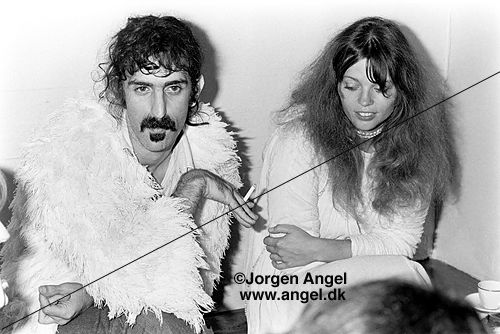 Fed up with the lack of financial means his career had brought him so far, in 1973 Zappa took a new approach to his albums, that was much more in line with what the general public expected of a rock artist. Instead of the recent albums, most of them either instrumental or bizarre story telling pieces, Zappa adapted the normal compiling of an album: a set of songs with lyrics, limited in size, without lengthy soloing. Besides that he took more sight of the spotlights by starting to sing most of his songs himself as far as his voice allowed him to do so. Because he had a limited vocal range, the more versatile parts still had to be sung by others. This, with a lot of deviation allowed, remained the course for the coming years.
Thus in 1973 appeared "Overnite sensation" (deliberately spelled wrongly) followed by "Apostrophe (')" in the next year,
both selling well. Apart from being commercially successful, Zappa personally also seemed to be fond of these albums. Most of their
tracks exist in live variants as well and he kept including songs from these two albums in every tour since they premiered.
Fed up with the lack of financial means his career had brought him so far, in 1973 Zappa took a new approach to his albums, that was much more in line with what the general public expected of a rock artist. Instead of the recent albums, most of them either instrumental or bizarre story telling pieces, Zappa adapted the normal compiling of an album: a set of songs with lyrics, limited in size, without lengthy soloing. Besides that he took more sight of the spotlights by starting to sing most of his songs himself as far as his voice allowed him to do so. Because he had a limited vocal range, the more versatile parts still had to be sung by others. This, with a lot of deviation allowed, remained the course for the coming years.
Thus in 1973 appeared "Overnite sensation" (deliberately spelled wrongly) followed by "Apostrophe (')" in the next year,
both selling well. Apart from being commercially successful, Zappa personally also seemed to be fond of these albums. Most of their
tracks exist in live variants as well and he kept including songs from these two albums in every tour since they premiered.
Frank and Gail Zappa in Denmark, 1974. Photo by Jorgen Angel, used with permission.
This section and the following one include a couple of examples of riffs from these albums ("I'm the slime", "Dirty love", "Don't eat the yellow snow").
For his more accessible songs Zappa often turned to riffs. Other examples of riffs in this study are for instance:
- Brown shoes don't make it, opening riff (Absolutely free section)
- Tell me you love me (Chunga's revenge section)
- Willie the pimp (Fillmore East section)
- Eat that question (Waka/Jawaka section)
- Titties 'n beer (New York section)
1. Camarillo Brillo
In the One size fits all section I'm briefly referring to "Camarillo Brillo" as an example of a two-theme pop-song. In the Ludwig study
(see the references) this song also gets mentioned for its verse-chorus structure and its use of common chord progressions. Obviously Zappa
wanted to appeal to a larger audience by starting an album like this.
The verse-chorus structure is the most common structure
in pop music, that also Zappa might use. The universe of different structures he could apply, however, is fascinating. See the One size fits all
section for an overview. In 2011 all of the "Overnite sensation" material got published via the Hal Leonard guitar songbook series. It's
done very accurately by Paul Pappas. The following example is the opening from "Camarillo Brillo", based upon this transcription and
filled in with some more details by me:
Camarillo Brillo (1973), opening (midi file).
Camarillo Brillo (1973), opening (transcription).
"Camarillo Brillo" begins with an instrumental riff in E. It's made up of two bars, that get played four times. The first
bars turns up about the same each time, but the second bar gets varied upon. The chord progressions are:
- bars 1, 3, 5 and 7: I-VI 7th-II-I.
- bars 2 and 6: IV 9th-II 7th.
- bar 4: V-IV.
- bar 8: II 7th.
In bar 1 etc. the II and I chords get mingled. The example continues with the verse (bars 10-13). Here the chord progression is I-V-IV-II-VI. This progression gets filled
in more and more towards the end with the players improvising along this pattern. The shorter verse gets repeated a couple of times,
before the second theme turns up. For this chorus the song first modulates to D. It lasts ten bars in total and doesn't get repeated before
the verse returns again. "Camarillo Brillo" is also available in a live version on for instance "Hammersmith Odeon", where Zappa
is using the tempo as a variation method. First it gets played much faster than on "Overnite sensation". Halfway it switches to slower.
Camarillo Brillo (1974), 2:58-3:12 (midi file).
Camarillo Brillo (1974), 2:58-3:12 (transcription).
The "Apostrophe (') 50th anniversary" CD from 2024 contains a 1974 live edition, recorded at Ohio, november 20th. During the chorus and verse, with Zappa singing the lead vocals, George Duke
is playing lightly all through. At 2:58 he raises his volume for soloing, using two keyboards. Zappa, who rather did not sing and play at the same time, joins in too on his guitar, skipping
the spoken part of the 1973 outro ("Is that a real poncho ...?"). On this occasion it truely ends as an instrumental version of the verse.
The example above contains two cycles of the four-bar verse. Not all is well audible, especially Ruth Underwood's part, who's playing marimba in the background.
The lyrics of "Camarillo Brillo" are about meeting a woman, who gets portrayed as some kind of voodoo-witch. It starts with comparing her rough hairdo with Brillo pads (iron-wired pads for cleaning).
Camarillo and Mendocino are towns in California.
2. I'm the slime - The curse of the Zomboids
"I'm the slime" starts with two melodic riffs, followed by Zappa doing a meltdown
(speechwise singing) about our TV set. This opening starts after a little intro with Zappa improvising on guitar.
I'm the slime, opening (midi file).
I'm the slime, opening (transcription).
It's using 12/8 and 4/4 as meters. These two meters
last exactly as long, so it's a change of subdivision: four times three becomes four times two. The keys change, but since
some notes aren't used, they can't be identified positively. Subsequently they are:
- F# Dorian or minor (the D/D#, that makes the difference, fails).
- E Dorian or Mixolydian. The G/G# isn't used, at least I'm not hearing it. Paul Pappas indicates an E chord, thus
going for the Mixolydian harmony.
- D Dorian. The instrumental opening does end positively with modulating towards D Dorian, the key the verse starts with.

The song ends with a guitar solo, maintaining the ambiguity about being in F# Dorian or minor. Now both the D natural
and D sharp are being used by the accompanying B and D chords. Above the first four bars of this solo (source: Overnite sensation guitar book, the meter is 4/4).
At this point the soloing avoids the D/D#, at some other points Zappa himself plays a D#, also when the accompanying chord is D.
The curse of the Zomboids, 2:42-3:15 (midi file).
The curse of the Zomboids, 2:42-3:15 (transcription).
In 2023 the ZFT released a "Overnite sensation 50th anniversary deluxe" edition with alternative takes and material from two concerts from the 1973 spring tour.
"I'm the slime" is included under two different titles as well. A 1972 recording called "Face down" without knowing who participated on it, and one from the
Hollywood Palladium concert, March 23, 1973. On that occasion Zappa himself introduced this song as "The curse of the Zomboids" during the preceding track, listed
as "The successor to Willie the pimp". The example from above is part of the guitar solo from it. This time the band is using F# minor pentatonic and F# minor (Aeolian):
- Bars 1-3: minor pentatonic with the bass using the line from the intro and chorus.
- Bar 4: the keyboards play D and E as chords, setting the environment to F# minor.
- Bars 5-10: the bass plays three times a progression, F#-E-D-E and back to F#. Now everybody is in F# minor.
Zappa follows suit by also using the D and G#.
- Bar 11: the bass line from the beginning returns, Zappa continues to use the G# from F# minor.
3. Dirty love
The main theme from "Dirty love" is following a riff with
two alternating chords, being I-VII in D Mixolydian. At 0:28 a second theme starts, following a parallel movement
of three major type of chords (C, D and E7).
Dirty love, opening (midi file).
Dirty love, opening (transcription).
Half-way this song you can hear a little guitar solo. During both "I'm the slime" and "Dirty love", Zappa
is playing over chord progressions. For the "I'm the slime" outro the chords F#m7, E, D and B are used in varying patterns. In case of "Dirty love" he
continues with the progressions from the two themes of this song. This is the most common manner of playing a solo
in pop music, but in case of Zappa pretty rare. See also the Guitar section.
Dirty love, end of the solo (transcription).
As indicated by Paul Pappas, the first four bars from the example above follow C-Cm7-Dm7-E9sus4, similar, though not identical, to theme 2. Bars five and six are using D-C,
as in the first example from above. As a guitar book everything gets notated for guitars. Guitar 4 is Zappa soloing. The other guitars represent
the accompaniment. The bass part normally isn't included in the Hal Leonard series, but can to a point be derived as the root note of the indicated chords.
4. Fifty-fifty
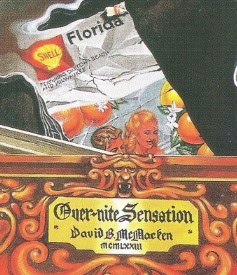 On the two albums of this section and the next one, "Fifty-fifty" is the only track where Zappa isn't singing himself. It would have asked too much
of his voice. The pitch range is wide and during the song the lead singer, Ricky Lancelotti, is deliberately yelling.
Zappa apparently liked him to do so and wrote the lyrics to go along with it ("I know my voice is kapoot").
To the right an outtake from the CD cover artwork by David McMacken.
Yelling is something Zappa himself never does on his albums, hardly ever even raising his voice. During the song you have a large instrumental middle block for three sequent solos.
All three follow the same modulation pattern, with as its basis:
On the two albums of this section and the next one, "Fifty-fifty" is the only track where Zappa isn't singing himself. It would have asked too much
of his voice. The pitch range is wide and during the song the lead singer, Ricky Lancelotti, is deliberately yelling.
Zappa apparently liked him to do so and wrote the lyrics to go along with it ("I know my voice is kapoot").
To the right an outtake from the CD cover artwork by David McMacken.
Yelling is something Zappa himself never does on his albums, hardly ever even raising his voice. During the song you have a large instrumental middle block for three sequent solos.
All three follow the same modulation pattern, with as its basis:
- 8 bars alternating C Mixolydian and Db Mixolydian.
- 8 bars alternating Ab Mixolydian and Cb Mixolydian. In all bars the bass is playing
the tonic as pedal note and the accompanying chords are mostly larger chords (7th to 11th) with the tonic as root.
Only in the final 16th bar the bass moves over to Eb.
- 8 bars again alternating C Mixolydian and Db Mixolydian.
- 8 bars again alternating Ab Mixolydian and Cb Mixolydian.
The three solo out-takes below are bars 5-10 plus the beginning of bar 11 from this scheme, that lasts 32 bars in total. Thus these corresponding blocks
present the same section as played by the three solo players. The scales are followed by the soloists with a lot of freedom. The first organ solo example
below begins with George Duke
playing as fast as he can over a C Mixolydian accompaniment, using the chromatic scale. Notes over the Db pedal bars can also
get altered. Especially Zappa alters notes consistently during his solo. Over the C pedal bars he changes the E to Eb, thus
mingling C Mixolydian with C Dorian. Over the Db pedal bars he always uses a C natural instead of a Cb and half of the time
the Gb also gets altered to G natural. So here Db Mixolydian gets mixed with Db major and Db Lydian.
The structure of "Fifty-fifty" goes as:
- 0:00 Instrumental intro in D Dorian.
- 0:15 Theme A, at first continuing in D Dorian.
The first half of theme A is a phrase of two bars over a bass pattern, playing around D-F-D-G. This phrase gets varied upon four times. The transcription below begins
with the last three variations.
The second half begins at the end of bar 6, where the varying upon the previous phrase is left and the music briefly moves over to Eb Dorian. Halfway bar 8
and during bar 9 the chords Em7, Em7-5 and C#m7-5 are used, not particularly staying in a specific key. The last C#m7-5 gets extended by an additional F by the bass played
beneath it.
Fifty-fifty, theme A (midi file).
Fifty-fifty, theme A (transcription).
- 0:40 Theme B. See the example at the end, where this theme returns instrumentally as the coda for this song. In the repetitions of this theme below, the harmonies come out
better. Here it's more melody and bass only.
- 0:56 Theme A again. The bass pattern returns in the same manner, but the melody gets harmonized differently.
- 1:22 Theme B again, now with chords.
- 1:38 Organ solo by George Duke. This solo and the next two follow the pattern as described above.
- 2:36 Violin solo by Jean-Luc Ponty.
- 3:35 Guitar solo by Zappa.
Fifty-fifty, organ solo section (midi file).
Fifty-fifty, violin solo section (midi file).
Fifty-fifty, guitar solo section (midi file).
Fifty-fifty, organ solo section (transcription).
Fifty-fifty, violin solo section (transcription).
Fifty-fifty, guitar solo section (transcription).
- 4:40 Theme A.
- 5:06 Theme B.
- 5:24 Theme A instrumentally.
- 5:49 Theme B instrumentally. Bars 1-4 are in C Phrygian. For bars 1-3 Zappa is using extended chords, I 11th for instance
on beat 2 of bar 1. From bar 4 onwards the chords are all standard triads. For the closing bars the music moves over
to E Lydian. Bar 6 continues for a couple of seconds with improvised notes till the song ends.
Fifty-fifty, theme B (midi file).
Fifty-fifty, theme B (transcription).
- 6:09 End
5. Zomby woof (1973) - Palladium jam
This title gets represented three times in Zappa's catalogue. The "Zomby woof (1988)" live version
gets dealt with amply in the Best band you never heard in your life section, where I'm describing the structure
of this song. Examples from the opening and the guitar solo are included. Stylistically it's the most complicated song from "Overnite sensation".


Above the opening of the guitar solo from "Zomby woof" (1973), as transcribed by Paul Pappas (the meter is 4/4). As it comes to their themes, the three
"Zomby woof" versions are basically the same. Some detail differences are pointed at in the Best band you never heard in your life section,
where you can also find a sample from the 1988 solo. These solos are the main difference between the three versions. All three are in A Dorian,
this one over a bass pedal note, the 1988 rendition over a vamp. As about always they get improvised anew on the spot. As also mentioned below
at "Dinah-Moe Humm", Paul notates the solo as if in minor, a convention in the Hal Leonard series. When the F/F# turns up, it's mostly as the F# from A Dorian.
In the example above the F/F# is still avoided.
Zomby woof, 1:39-2:10 (midi file).
Zomby woof, 1:39-2:10 (transcription).
This second example is a section specifically transcribed from the "Overnite sensation" version. It contains:
- Bars 1-2 in 7/8 and 5/4 with what I'm calling theme four in the Best band you never heard in your life section.
This theme can be called diatonic, the others are chromatic/atonal.
- Bars 3-6: an instrumental bar in 10/16 with two melodic lines played against each other. It gets repeated three times
where two keyboards are playing in different angles of the stereo field, sometimes one keyboard alone, sometimes both.
- Bars 7-8: a variation upon bars 1-2, now in 7/8 and 6/4.
- Bar 9: first bar of what is called the interlude in the Overnite sensation guitar book. Two figures are played against each other in 4/4.
The melody and the rhythm from my staff 4 go different from their presentation in the Guitar book. My guess is that in the Guitar book this
melody could be taken over from a score by Zappa. The Guitar books were commissioned by the ZFT, handing over copies of available scores and draft versions then
becomes logical, but no mention is made of this. During the recording session this melody got changed and it could also be varied upon. If I'm right
then this would be another example of what happened often: scores already got adapted during their first recording.
- Bar 10: a bar played in parallels. So you can see meters changing, themes and motifs changing, diatonic and chromatic bars and an alternation between a monodic/homophonic and polyphonic
writing style. It's what makes this song complex.
- Bars 11-13: the previous two bars in different shapes.
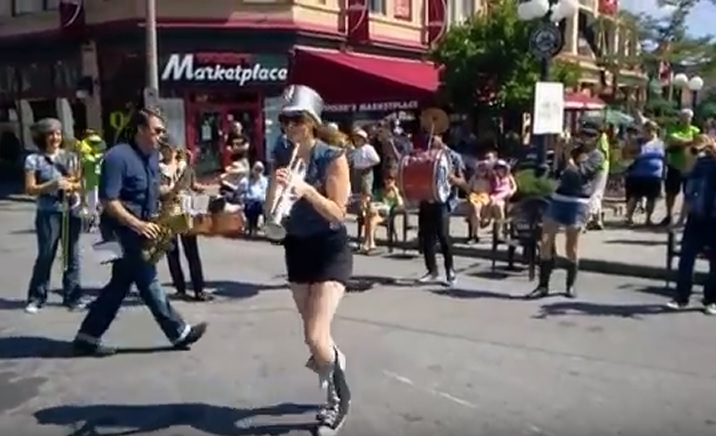

A street band calling themselves the Asphalt Orchestra playing "Zomby woof" during the Ottawa Chamberfest, 2011.
Not something one might expect to happen. It can be found on Youtube. They're doing quite all right.
As also mentioned above, the "Overnite sensation 50th anniversary deluxe" edition contains half of two concerts from the 1973 spring tour.
While the Cobo Hall concert part has the accent upon written titles, the tracks from the Hollywood Palladium know a lot of improvising.
Track 6 from CD 3 knows an earlier stage of "Don't you ever wash that thing" at that time also including the "Echidna's arf" themes, played towards the end.
It lasts 23:26 with in between the written themes a lot of improvising. The following tracks 7-9 are all about improvising. Track 7 is for the percussion section
with Zappa participating. Track 8 is for the band. First George Duke is playing and singing in a way typical for him, some sort of fast jazz, next Jean-Luc Ponty
plays a solo. Track 9 begins with Zappa playing a guitar lick.
Palladium jam - part 2, 1:48-2:17 (midi file).
Palladium jam - part 2, 1:48-2:17 (transcription).
Ricky Lancelotti, who's singing lead on "Fifty-fifty" is also taking care of some of the sung parts from "Zomby woof". He also had a guest appearance
during the Hollywood Palladium concert, but didn't become a steady band member. There's a photo of him in the "Overnite sensation 50th anniversary deluxe" booklet
with some background information about him beneath it. During track 9, called the "Palladium jam - part 2" he's singing in the same manner as during "Fifty-fifty" and "Zomby woof",
now entirely improvised and with lyrics that are hard to follow, and not really meant to be followed, I guess. The example from above is about half a minute
from the "Palladium jam - part 2". Its basis is A Dorian. Bars 1-4 can be called typical of a band jamming in standard 4/4. At bar 5, 2:00 on the CD, Zappa begins soloing.
As you can see, he's using C# and C natural next to each other, what you might call a mingling of Dorian and Mixolydian, common in his output.
A couple of bars from the A Dorian part of this example can also be called minor pentatonic, the F# doesn't get used often and the B is largely avoided.
6. Dinah-Moe Humm
"Dinah-Moe Humm" has become more famous for its lyrics than for its music. The original side two of the vinyl album corresponds with tracks 5-7
on the CD. It's all surreal fiction, humoristic, and it can be seen as a form of literature.
Dinah-Moe Humm, main theme (midi file).
Dinah-Moe Humm, main theme (transcription).
The main theme from "Dinah-Moe Humm" is another example of major chords being played parallel. It's diatonic music, but not following
one particular scale. Instead it's touching upon a couple of major type scales, with notes getting altered all the time. This situation has been addressed
too as well in the Freak out and YCDTOSA Vol. II sections from this study, with some more remarks in the modulation paragraph from the Studio tan section.
As indicated in the Overnite sensation guitar book, the basic chord progression in bars 1-2 and 5-8 is E-F#-E-D-A-E-F#-G-G7-D7-B7.
It's getting played around in the example above, a rather literal reproduction of how the main theme is played between 0:08 and 0:24.
In the guitar book the main theme gets notated as in E, which I'm following here.
Dinah-Moe Humm, main theme, bars 1-2 and 5-8 pasted together (midi file).
Bars 3-4 are there to break the pattern, something Zappa liked to do. It's a little atonal sequence, its irregularity being stressed by its
accompanying chords. The minor-seconds distances between the subsequent notes are +1+8-8+1+9-9+1+9-9+1+10-1, so this atonal melody does have
some form of a pattern by itself (plus is going up, minus is going down). The bass line is chromatically moving down from A to F#. Rhythmically it stays in standard 4/4.
The second midi file from above contains the main theme without
these interrupting bars. One has become used to their presence, but this is how the main theme would sound in a more regular pop-like way.
Following the guitar book, the global structure of "Dinah-Moe Humm" goes as:
- 0:00 Intro with drums and the E-chord by a rhythm guitar.
- 0:08 Verse (main theme from above), being played three times.
- 0:57 Chorus, appearing only once during the song.
- 1:10 Interlude (Dinah-Moe speaking).
- 1:42 Bridge, being the Dinah-Moe and her sister story, with a sample from it shown below.
- 4:49 Drums and rhythm guitar as at the beginning.
- 4:57 The verse returns.
- 5:26 Outro.
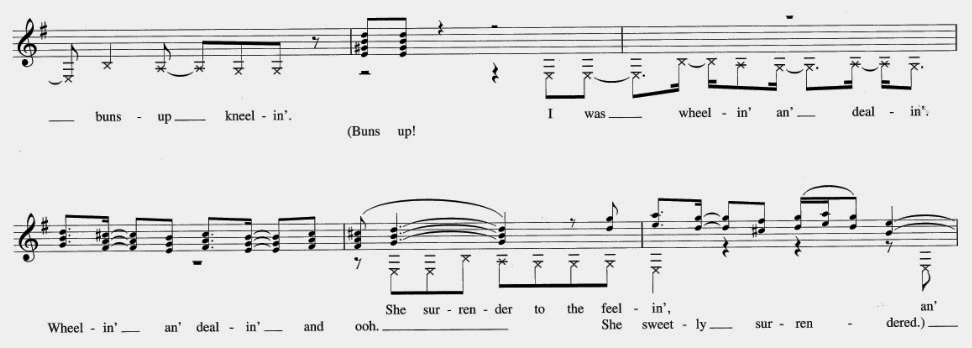
Sample from the Overnite sensation Guitar book, page 81, with Zappa speech-wise singing and vocal harmonies by the Ikettes.
The meter is 4/4 and the accompanying riff (page 79) is pulsing an Em chord.
The bass, playing along the Em chord, is mostly giving an E pedal, the key at this point thus being E Dorian.
It's a convention in the Hal Leonard guitar book series to always notate songs as if in major or minor. Because Zappa actually composes modally,
you have to be aware of this manner of notation.
Zappa kept performing "Dinah-Moe Humm" live as well, but the studio version works out better for its finesses, lying in the background vocals
and comments by the Ikettes. He has sometimes been accused of being women-unfriendly. In case of "Dinah-Moe Humm" this gets compensated by its wit, but the subject
of songs like "Dirty love" and "Bamboozled by love" can be called ugly or insensitive. Zappa standard defense would be that he had a right
to write about anything happening in society and that his songs could be unfriendly towards males as well.
Dinah-Moe Humm (Erie), 1:16-1:47 (midi file).
Dinah-Moe Humm (Erie), 1:16-1:47 (transcription).
Despite of performing it often, the song kept being played largely the same. The Erie concert of November 1974 is an exception. It can be found on the 2022
ZFT release "Zappa/Erie". On this occasion the second phrase from what's called the interlude in the Guitar book got replaced by another phrase.
The tempo change is drastic. What was two 4/4 bars has now become four 6/4 bars.
Only the chord progression of this phrase is similar. Bars 1-4 from the example from above represent the first phrase, two times.
In the guitar book the chords are notated as E-D-A. At Erie the chords are implied at best with the G# having become G natural. The key in the Guitar Book is thus E Mixolydian,
while at Erie it's E Dorian (such switches are common in Zappa's music). Bars 5-12 contain the second phrase in 6/4, also two times (on the CD both phrases are played four times in total).
Here the chord progression is Em7-D-C, the key having become E minor. I've included the corresponding bars from the guitar book below my example.
7. Montana (1973)
One can also encounter riffs in far more complex environments
as the bass movement in bar 7 of "Montana", the closing song for "Overnite sensation" with amusing absurd
lyrics about growing dental floss. The set-up of this song goes as:
0:00 Instrumental intro of 4 bars in A Mixolydian.
In his 2009 study Brett Clement looks at the melodic line and bass only and identifies it as A Lydian. Presented like this it indeed looks like that.
When you include the harmony notes it gets different. In his response to me, however, you can read that Brett wishes to maintain his interpretation:
"there's a melodic D# which is clearly part of the theme; the accompanimental G and C are just there to create
parallel major triads, with the melodic note functioning as the chordal third". In my interpretation it's more likely
that Brett simply forgot to listen to the harmony notes
and got too eager to call it Lydian. Brett: "Why? The "main" diatonic collection for a large portion of
that song is clearly 4#, which appears as B Mixolydian in the verse and
F# Dorian in the solo. Therefore, when the theme appears in the
introduction over an A pedal, I analyze that as the Lydian pedal of the
4# diatonic system. In other words, I read the harmony note G as a nonscale
tone, whereas Sloots analyzes the melodic D# as a non-scale tone."
It is true that what you're seeing here is a form of parallel chords (which is common in Zappa's music), and
this is causing quite some altered notes to be present, whatever scale you choose. In situations like this one should simply
look for the best fitting scale (following the Guitar book presentation):
- A major: 25 notes are altered.
- A Mixolydian: 12 notes are altered.
- A Lydian: 30 notes are altered.
Quite obviously A Mixolydian is the scale that suits the best (encircled notation examples are included below). To my ears in such a degree that the D# in bar 3 also really
sounds as an altered note. In 2022 the ZFT released an earlier recording from 1972 of "Montana (1972)", which confirms
my reading.
0:10 Two bars of drum soloing.
Montana, opening (midi file).
Montana, opening (transcription).
0:15 Verse:
- phrase 1: 4 bars in B Mixolydian with the chord progression basically being two times VII-I. These chords are mostly not
played as triads, but get extended with additional notes and passing-through notes. At the beginning these chords a played softly
in the background, but they come out more accentuated in the third Montana example below.
- phrase 2: 4 bars in A Mixolydian.
- phrase 1: 2 bars, transposed up a minor second, thus in C Mixolydian.
- phrase 3: chord progression, being Em-A-Dm-G.
0:48 Smaller interlude.
1:00 Verse restarts.
1:33 Chorus of four bars, played twice (B Mixolydian).
1:55 Guitar solo in F# Dorian. See the previous Imaginary diseases section for how this solo got played in 1972, quite differently
over a vamp in F# Aeolian.
3:23 Larger interlude.
Montana, 3:23-3:56 (midi file).
Montana, 3:23-3:56 (transcription).
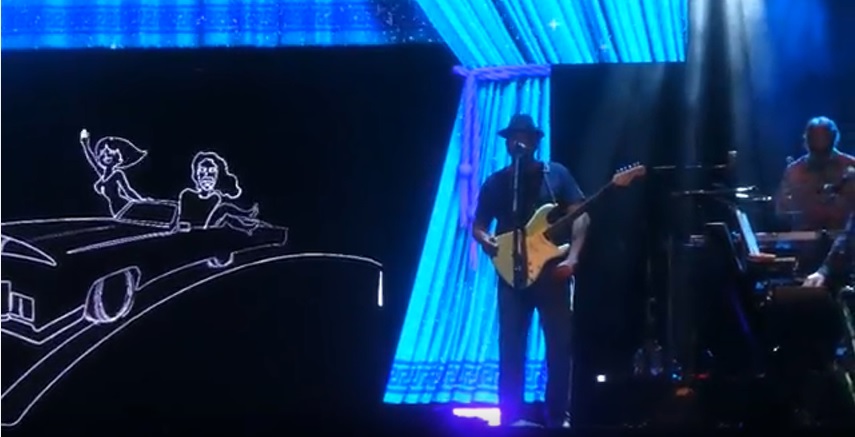
Above: screenshot from the 2019 The bizarre world of the Frank Zappa tour, with Ray White singing "Montana".
Below to the right: Tina Turner with Oprah Winfrey at the height of her career.
At the time Zappa was recording
this album, Ike and Tina Turner and the Ikettes were recording in the same studio.
Zappa was looking for back-up vocalists and was surprised that Tina and the Ikettes were willing
to do the job. It is often said that Zappa brings out the best in musicians and that's what's
happening here. Tina and the Ikettes felt challenged by the vocal part in the middle of the song,
partly transcribed above.
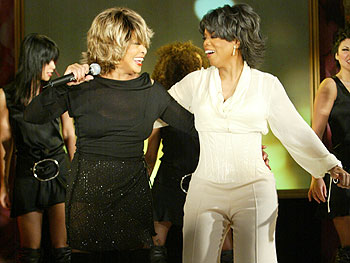 Zappa: "It was so difficult, that one part in the middle of the song "Montana",
that the three girls rehearsed it for a couple of days. Just that one section. You know the part that
goes "I'm pluckin' the ol' dennil floss..."? Right in the middle there. And one of the harmony singers
got it first. She came out and sang her part and the other girls had to follow her track. Tina was so
pleased that she was able to sing this that she went into the next studio were Ike was working and dragged
him into the studio to hear the result of her labour. He listened to the tape and he goes, "What is
this shit?" and walked out" (quote taken over from Barry Miles' biography). Ike refused the name of the Ikettes being
used for credits. On this occasion they were Tina Turner, Linda Sims and
Debbie Wilson (see the "Overnite Sensation/Apostrophe (')" DVD at 20:12 minutes for the bill). Zappa is in much of
Montana again singing a meltdown, opposed to the highly flexible lyrics by Tina and the Ikettes. The transcription
shows on paper how difficult indeed their part is. It has constantly changing rhythms, strings of fast notes and
unorthodox harmonic progressions, using all intervals. It's played in the form of a two-part counterpoint
by the descant and the bass. It's diatonic material, but with the bass moving all the time and a couple
of notes switching between natural and sharp, it's impossible to assign bars to keys. There are hardly chords in this part.
Zappa: "It was so difficult, that one part in the middle of the song "Montana",
that the three girls rehearsed it for a couple of days. Just that one section. You know the part that
goes "I'm pluckin' the ol' dennil floss..."? Right in the middle there. And one of the harmony singers
got it first. She came out and sang her part and the other girls had to follow her track. Tina was so
pleased that she was able to sing this that she went into the next studio were Ike was working and dragged
him into the studio to hear the result of her labour. He listened to the tape and he goes, "What is
this shit?" and walked out" (quote taken over from Barry Miles' biography). Ike refused the name of the Ikettes being
used for credits. On this occasion they were Tina Turner, Linda Sims and
Debbie Wilson (see the "Overnite Sensation/Apostrophe (')" DVD at 20:12 minutes for the bill). Zappa is in much of
Montana again singing a meltdown, opposed to the highly flexible lyrics by Tina and the Ikettes. The transcription
shows on paper how difficult indeed their part is. It has constantly changing rhythms, strings of fast notes and
unorthodox harmonic progressions, using all intervals. It's played in the form of a two-part counterpoint
by the descant and the bass. It's diatonic material, but with the bass moving all the time and a couple
of notes switching between natural and sharp, it's impossible to assign bars to keys. There are hardly chords in this part.
Montana, 3:56-4:25 (midi file).
Montana, 3:56-4:25 (transcription).
4:07 Verse again.
4:41 Smaller interlude.
4:52 Verse restarts.
5:26 Chorus variant as outro.
6:34 End.
